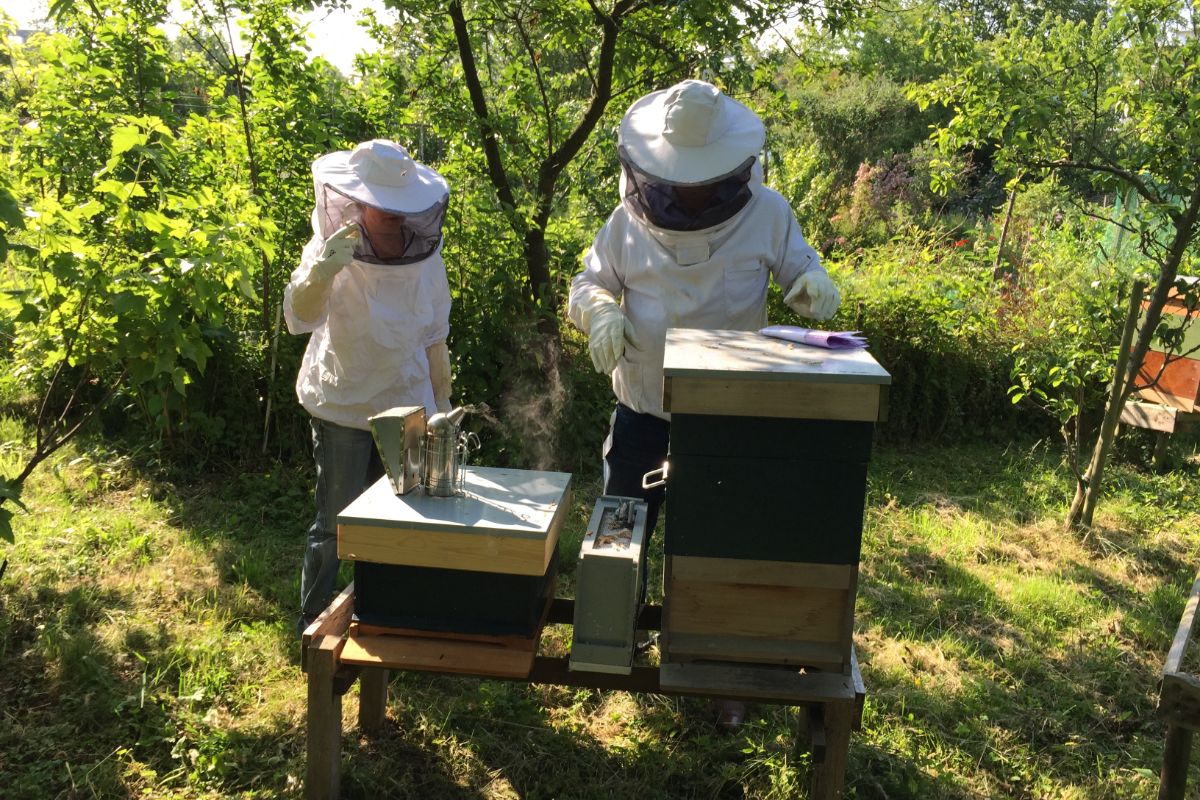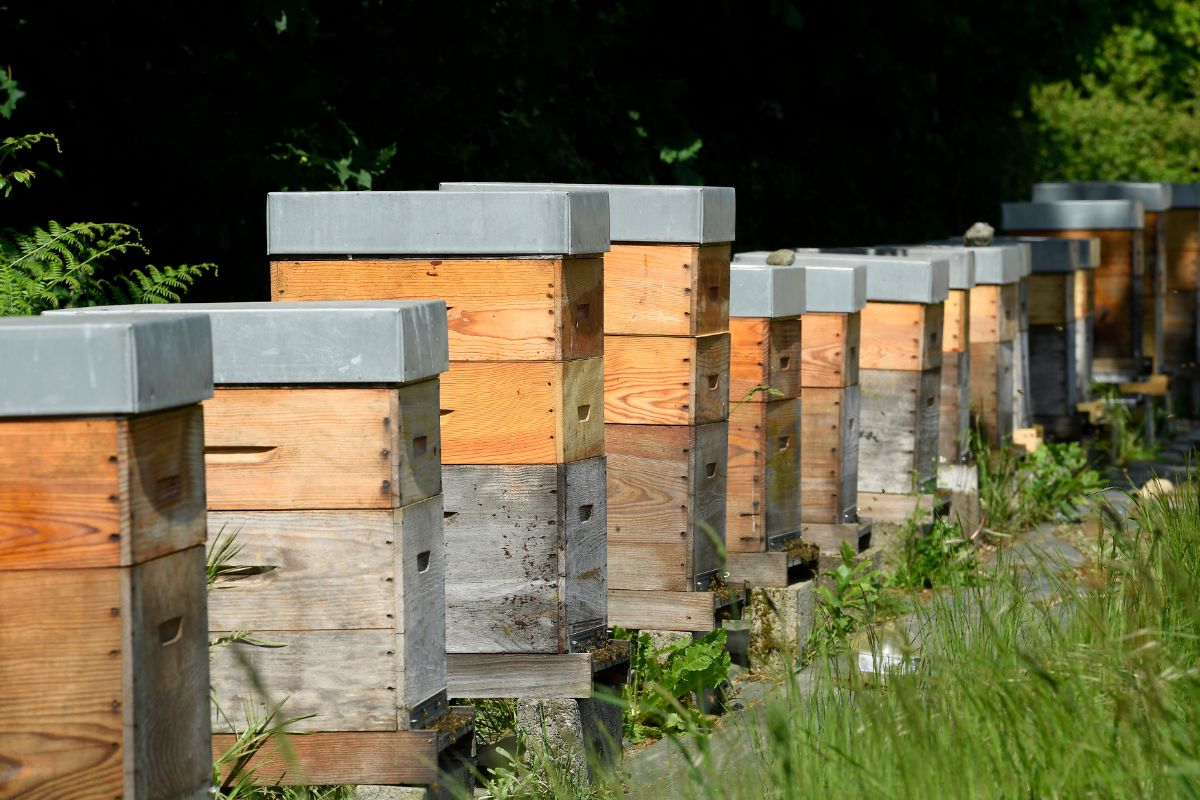Wintering bees can be very difficult, especially in Northern climates! Like all other creatures on earth, bees have their way of coping with cold weather.
They gather a winter reserve, and they huddle together to produce heat and stay warm.

However, while they do have their survival mechanisms, there are lots of things that you can do to ensure their best chances of survival.
We’ve compiled a list of the best things that you can do for your bees this winter! Read on to find out more.
Steps To Winterizing Your Hive
Move Your Bees
The first step in preparing your hive for the winter is to move your bees into the best possible position.
As winter approaches, it is only a matter of time before the darkness will extend, and the nights will become much colder.
When this happens, you will want your bees to be in the best position to get the full winter sun for as much of the day as possible.
This is an essential step to keeping your bees alive, as it will ensure that the temperature within the hive doesn’t drop too low.
When you have selected your location, you will have to figure out the best way to move them! Bear in mind that you want to keep your bees away from any traffic if possible.
Protect Them From The Wind
The next step in protecting your bees during the winter is to ensure that they are in a location that is not likely to be hit by strong winds. This is to prevent the hives from falling over in any winter storms that might come your way.
When you are choosing the location, consider the common direction of winter storms in your area. If your hives are hit by the wind it is likely that the bees will not be able to survive.
To protect your bees from the wind, there are a few steps that you can take. Consider:
- Placing them near a tree line
- Putting a fence up around the hive to block the wind
You will need to find the right balance of exposure to sunlight and protection from the wind for your bees to survive the winter!
Ensure The Hive Is Properly Ventilated
You will need to ensure that the hive is properly ventilated so that it doesn’t get stuffy. Consider the feeling you get when you’re stuck inside for too long. Bees can feel the same!
During the winter, bees gather together in a cluster inside the hive. They do this to produce heat and keep themselves warm. When they do this, they also produce a small amount of moisture.
This moisture will turn to condensation if there is no proper ventilation inside the hive, and this condensation can cause your bees to die.
To ensure that the hive is properly ventilated, you should tip the roof up at a slight angle to let a small amount of air into the hive. Don’t let too much in, though, as this can make your bees very cold!
Leave The Door Ajar
You don’t want to shut the front door of the hive all the way, but you will want to ensure that you attach a smaller reducer to the front of the hive.
In the summer, the hive entrance needs to be large so that the bees can fly in and out of the hive easily. This is important because they need to be able to collect food and make honey for the winter.
When the cold descends and the winter hits, you won’t need as big an entrance to the hive. The bees won’t be flying in and out as much, and there are fewer bees in general, too.
The bees will spend much of their time inside the hive ensuring that the queen bee is warm and that they are warm, too.
Adding a smaller reducer to the hive will mean that the bees can still move freely, but the hive will be protected from the wind and cold.
Reduce The Size
Some hives will have grown several bodies tall in the summer. If this has happened to your hive, then you will want to decrease the size of the hive bodies.

You can simply take a few of the hive bodies away to ensure that the bees are not in distress.
The bee population will decrease during the winter months, so they won’t need all that space. The extra space in the hive will just mean that it will be more difficult for the bees to keep it warm.
Cover The Hives
If you live in Northern areas that get very cold in the winter, it is a good idea to cover your hives. If you live in the South, you won’t need to complete this step.
If you live in an area that experiences a lot of snow and harsh winters, then you will want to invest in a hive cover! These covers slide easily onto your hive, and they help to keep the hives a little bit warmer.
Feed The Bees
There is not much food available for bees in the winter months. They do not leave their hives because of the cold, and, when they do, there is little food to be found.
Because of this, you will need to make sure that you provide them with a supply of food before the winter descends.
There are a few ways that you can feed the bees. These include feeding them fondant which comes in a block and should last one hive through the winter.
If you don’t want to purchase the fondant, you can make it for your bees. It is a combination of water, sugar, and vinegar.
Keep Thinking About Them!
While you will not need to check on your bees through the winter, you should always ensure that you are thinking about them and what they may need.
When you are wintering bees, for the most part, they will need to be left alone. However, you may need to check on their food supply now and again.
To check their food supply, you will want to choose a day that is over 40 degrees Fahrenheit. Raise the lid quickly, check the supply, and put the lid back on pronto!
The most common reason for losing hives in the winter is starvation and freezing, so this is something that you want to keep an eye on.
Choose The Right Time
It is important to make sure that you begin wintering your bees at the right time. This is usually related to the behavior of your bees and the weather, rather than an exact date.
When the weather begins to get cold, it is time to begin wintering your bees. This is usually at the end of October, or the start of November, depending on your location and the weather that year. It is a good idea to do some specific research on wintering bees in your area.
Stay Calm!
It can be worrying to leave your bees out in the cold, but all you can do is try your best and stay calm!
If you carry out all the necessary steps to keep them healthy and warm during the winter months, then that is all that you can do. Winter will eventually pass!
Beekeeping Through The Seasons
Winterizing a beehive should be fairly easy, as long as you roll with the seasons and respond to the weather. Beekeeping changes from season to season and the things you need to do will vary depending on the time of year.
Springtime
During the Spring season, you should inspect your colony regularly. This is the season when your queen must be present and laying eggs. You should be keeping an eye on whether or not this is happening.
As well as this, Spring is an important time to check that there are no signs of diseases present. You should provide medication to your bees to prevent diseases.
This should be administered until early June when you will need to stop so that it doesn’t get into the honey.
Until there is nectar and pollen available to the bees, you will need to ensure that the colony has enough food to get them through.
Summer
In the Summer, you will need to ensure that your bees have plenty of room in their hive, otherwise, they might swarm.
You should monitor your bees and add supers as the hive becomes full of honey. When the frames are full of honey and half of the cells are covered with wax, you will need to begin extracting your honey.
To do this, you will need to remove the super and frames from the hive.
Fall
During the Fall, you will need to examine the colony. Check that they are free of disease and that the queen is still viable.
Winter
During the winter, as explored above, you will need to winterize your bees. You should also check the hive and repair any holes. During the winter, some of the bees will leave the colony and die.
Final Thoughts
This article should have given you all the information you need to know about winterizing your hives! If winter is coming, and you’re not sure what to do, we’re here to help!
Follow the steps laid out in this article to ensure that your bee hive stays strong and healthy through the winter.
Frequently Asked Questions (FAQs)
When you are winterizing a beehive, you will not want to completely close the hive. This is because poor ventilation in the hive can cause mold.
Wet and cold weather will also encourage mold. Instead, you should wrap the sides of the beehive, and not the top or the bottom.
When you are insulating a hive, you should consider setting up a wind barrier to protect the colony during the winter.
You will want to make sure that you leave enough food in the hive to keep your bees fed through the winter.
The most common cause of death for bees in the winter is hunger, so it is important to make sure that they have enough food. You can buy food in blocks and leave it in the hive, or you can make your own.
It is important to keep checking to make sure that the food supply is not running low. You should only check when the temperature outside is over 40 degrees Fahrenheit, otherwise, the bees will be hit with a cold blast when you lift the lid of the hive.
- Do Bug Zappers Kill Bees? Completely Explained - April 9, 2024
- Does Brake Cleaner Kill Bees? Full Explanation - March 20, 2024
- Do Bald-Faced Hornets Kill Honey Bees? & How to Protect Them - March 4, 2024
